A new report on the effects of climate change revealed that areas of extreme drought have tripled worldwide since the 1980s. 48% of the Earth’s land surface experienced at least one month of extreme drought last year.
This was detailed in the Lancet Countdown on Health and Climate Change analysis, representing an increase from an average of 15% during the 1980s.
Almost a third of the world experienced extreme drought
Almost a third of the world, that is, 30%, experienced extreme drought for three months or more in 2023. In the 1980s, the average was 5%.
 The increase in droughts.
The increase in droughts.
The Lancet Countdown report provides some of the most up-to-date global data on drought and shows how rapidly it is accelerating.
When talking about extreme drought
The threshold for extreme drought is reached after six months of very low precipitation or very high levels of plant and soil evaporation, or both.
It represents an immediate risk to water and sanitation, food security, public health, and can affect energy supply, transportation networks, and the economy.
The causes of each drought are diverse and complex. There are many different factors that affect water availability, from natural climate phenomena to how humans use the land.
Climate change is also altering global precipitation patterns, making some regions more prone to drought.
The increase was particularly severe in South America, the Middle East, and the Horn of Africa. In the South American Amazon, drought threatens to alter weather patterns.
Among the consequences is the death of trees that play a role in stimulating the formation of rain clouds. This disrupts delicately balanced rain cycles, creating a feedback loop that leads to more droughts.
The other side: extreme rainfall
However, according to the report, at the same time, extreme rainfall also increased.
 Drought favors the spread of fires.
Drought favors the spread of fires.
In the last 10 years, 61% of the world experienced an increase in extreme rainfall, compared to the reference average for the period 1961-1990.
The relationship between droughts, floods, and global warming is complex. Warm weather increases soil water evaporation, making periods without rain even drier.
Additionally, as the oceans warm up, more water evaporates, and since the air is also warming, it can hold more moisture. When that moisture moves over land or converges in a storm, it causes more intense rainfall.
The report concluded that the health impacts of climate change were reaching record levels.
Last year, drought exposed 151 million more people to food insecurity than in the 1990s, contributing to malnutrition. Heat-related deaths among those over 65 also increased by 167% compared to the 1990s.
Have you visited our YouTube channel? Subscribe!

